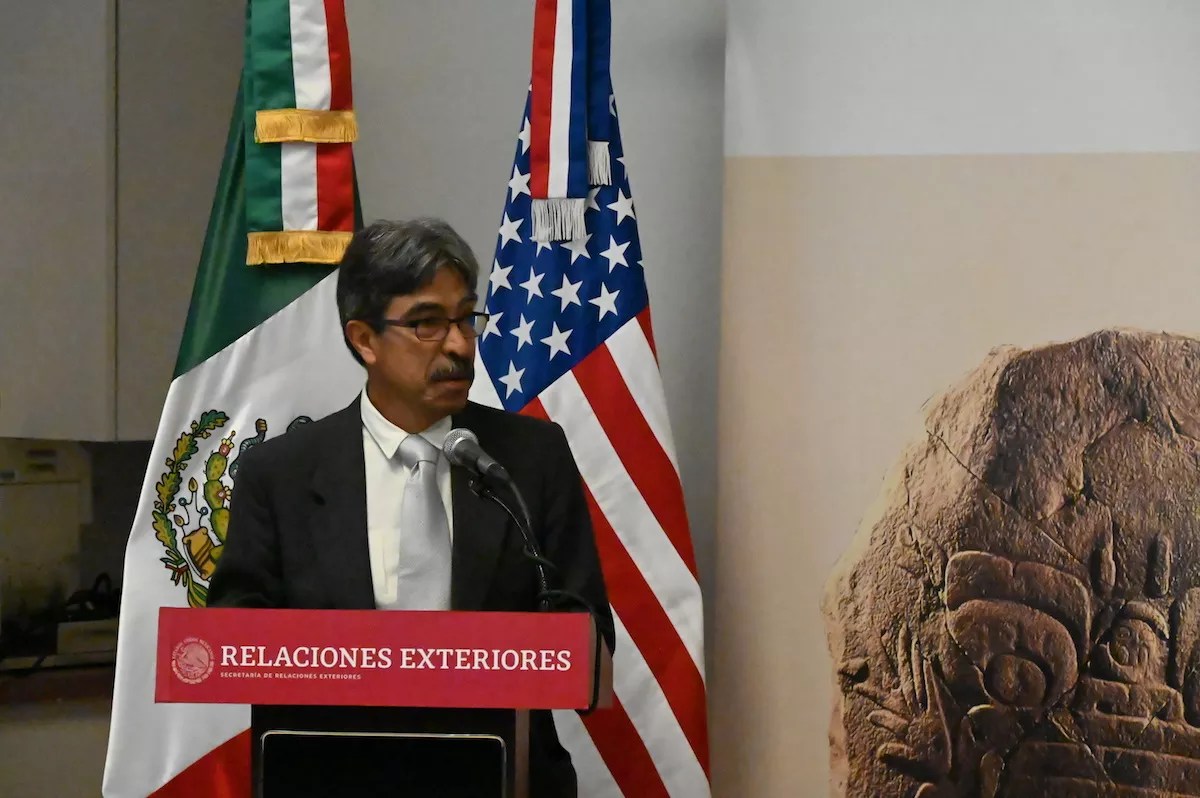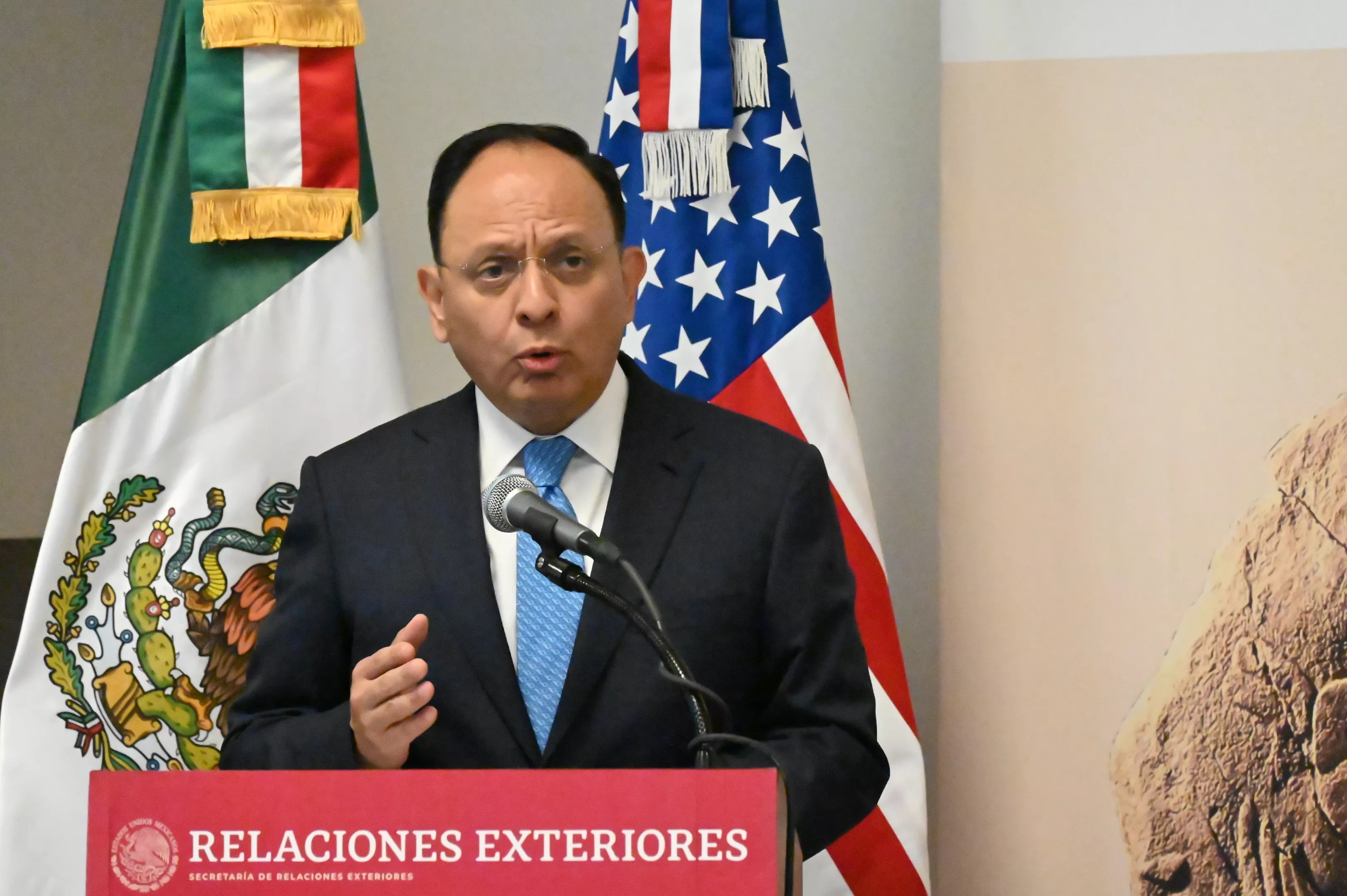
Bennito L. Kelty

Audio By Carbonatix
A highly sought-after ancient artifact from Mexico, which was kept under wraps in Denver after being found in a private Colorado art collection, has finally been returned to its home country more than half a century after it mysteriously vanished.
The one-ton stone carving – dedicated to an Olmec creature that’s believed to be guarding a portal to an underworld – was repatriated and made property of the Mexican government last week; it was flown back across the border on Friday, May 19, from Denver International Airport. Mexican officials have praised the move, calling it a major accomplishment that means the world to Mexico’s people.
“Our cultural heritage allows us to generate a sense of belonging that serves as acts of linkage with our roots,” said Jorge Islas, Consul General of Mexico in New York, whose legal complaint last year finally brought back the highly sought national treasure.
“The restitution of this piece will allow us to understand more of our ancestral culture,” Islas added.
Will you step up to support Westword this year?
At Westword, we’re small and scrappy — and we make the most of every dollar from our supporters. Right now, we’re $21,000 away from reaching our December 31 goal of $50,000. If you’ve ever learned something new, stayed informed, or felt more connected because of Westword, now’s the time to give back.
The “Earth Monster” – also called a dragon or jaguar based on its design – was repatriated at a ceremony at the Signature Flight Services building near DIA with several Mexican officials, including Islas, in attendance. The monolith was kept in its crate before being shipped off on a cargo plane with a military escort back to Mexico. It will stay at the Palacio de Cortés in Cuernavaca, south of Mexico City, before being returned to its home at an archeological site in Chalcatzingo, Morelos, in September or soon after.
Like any good ancient-relic story, mystery surrounded the details of the Earth Monster’s arrival in both the United States and the Mile High City after its repatriation was announced earlier this month. On Friday, officials finally pulled back the curtain on the monolith’s journey to Colorado and where it had been before its arrival in Denver.
Made out of a 21-million-year-old type of volcanic rock called granodiorite, it was stolen and cut into eighteen pieces sometime in the 1950s or early 1960s before being brought to the U.S., where it was reassembled in the 1970s and eventually put on public display at an exhibition at New York’s Metropolitan Museum of Art.
It was put on display in upstate New York in the 1980s and then again in Chicago in 2004 and 2006, according to Alejandro Celorio Alcántara, principal legal advisor for the Mexican Foreign Affairs office. Its appearance in 2006 was the last that Mexico had known of the Earth Monster’s whereabouts before it went off the grid again.
“A lot of people in the U.S. were looking for it,” noted Mario Córdova Tello, a researcher for the Mexican National Institute of Anthropology and History. “A lot of people in North America were looking for it.”
The monolith was possibly removed by “people of war” working for collectors, said Córdova at Friday’s ceremony. Mexican officials don’t know exactly when it showed up in the U.S. or how it got into the country.
In addition to Earth Monster, the relic also bears the name “Monument 9 of Chalcatzingo” because it’s one of multiple artifacts left behind by the mysterious Olmecs in the region. Friday’s repatriation ceremony was attended by Mexican Foreign Secretary Marcelo Ebrard and Colorado Lieutenant Governor Dianne Primavera, as well as by Islas and Córdova.
“Monument 9, crafted by the ancient Olmecs, deserves to be in its ancestral home,” Primavera said. “And the people of Colorado are happy to do our part in making that happen.”

Mexico Foreign Secretary Marcelo Ebrard talks about the importance of bringing the “Earth Monster” back to Mexico.
Bennito L. Kelty
Since 2018, more than 10,000 artifacts have been returned to Mexico from the U.S., according to Primavera. Córdova says that this relic is of particular importance; since he’s been working in Chalcatzingo, understanding the piece’s iconography has been one of his “main tasks.”
“This monument, we didn’t get to see…just for a time in a little drawing until photographs started to come out,” Córdova says. “We’re very grateful. I’m very grateful.”
Mexican officials first learned of the monument’s removal – and that it was in the U.S. – in 1968, when archaeologist David Grove mentioned its presence stateside in an issue of the journal American Antiquity.
“The greatness of Mexico doesn’t only depend on the size of its population or its economy,” Islas explained. “It also depends on its history and its cultural diversity.” According to the consul general, although Mexican officials knew that it was in the U.S. being displayed in famous museums, they never began the legal process of working with American authorities to pin down its location or find out who took it until after he filed a criminal complaint in June 2022, after which the wheels were set in motion.
The Mexican government was notified earlier this year that the monolith was recovered by the Manhattan District Attorney’s Antiquity Trafficking Unit, a team formed in 2017 to deal with the nonstop trade of stolen antiquities from historic sites around the globe. A 2021 article in The Atlantic referred to the unit as the “Tomb Raiders of the Upper East Side.”
Shortly after the unit was put on the case, it was discovered that the Earth Monster was being kept in a private collection in Colorado. Ebrard confirmed its recovery in a March 31 tweet, saying “the Olmec piece most sought after by Mexico…[is] about to return to its home, from where it should never have been stolen.”
The monolith was located on a property in Colorado, but officials did not say where. It is believed that the owner thought he bought it from people in Mexico and that “it changed hands multiple times,” Alcántara says.
“He had [the Earth Monster] in his house,” Córdova noted.
The long-lost relic made stops in Washington, D.C., in addition to New York and Chicago over the years, while also being featured in “a lot of American archeological publications,” according to Córdova.
“This piece always, always was being shown off, but nobody said anything,” Córdova said.
It was normal at one time for archeological pieces to be taken and sold to collectors, he added, but now more international patrolling, including by agencies like INTERPOL – the International Criminal Police Organization – enforce against it.

Mario Córdova Tello, a researcher for the Mexican National Institute of Anthropology and History, talks about the meaning of the iconography on the “Earth Monster.”
Bennito L. Kelty
Córdova started making efforts with Mexico’s Foreign Affairs office and writing letters to bring back the artifact around 2005, he says. But it wasn’t until Islas made his criminal complaint that anything happened, which Córdova says was “a political deed.”
Mexican officials gave few details beyond that, with Alcántara saying it would be “up to an investigation” to find out more. Who paid to have the monolith stolen and cut up remains unknown, but Mexico believes that someone was paid to sneak onto its archaeological site and remove and transport it for a high-paying collector, undoubtedly “in clandestine fashion,” he added.
The recovery of the Earth Monster is the biggest win for the Mexico Foreign Affairs office that Alcántara has ever seen, he said.
“The recuperation of this piece is a step that restores part of the greatness of the mother culture of all Mexicans,” Islas added. “The repatriation of this monument was a formidable challenge.”
The Earth Monster is about five feet wide and six feet tall. The most well-known Olmec artifacts are iconic colossal heads that were found near the Gulf of Mexico, but the Earth Monster looks different and is also rich in iconography. Images are sculpted into the face of stone, and the outer edges are shaped like a hill “that represents the hills of Chalcatzingo,” per Córdova.
The Earth Monster ultimately represents a mythical being with human and animal-like features, including the nose of a snake and the representation of the face of a jaguar – which is one of the most feared and revered creatures in Mexican history.

Jorge Islas Lopez, the Consul General of Mexico in New York, whose criminal complaint brought the “Earth Monster” back to Mexico, talks about its importance for their heritage.
Bennito L. Kelty
In the center of its face, the Earth Monster has a feline mouth in the shape of a cross, which is surrounded by a series of wave-like circles intended to give the piece depth and a sense of grandeur, as well as a portal-like cave look.
The Chalcatzingo mountains and region from which the Earth Monster is believed to have originated have deep caves and caverns, with water springs and plants adorning its landscape. The hills of these mountains “gave a lot of water at this time, 2,800 years ago,” Córdova says, adding that the monument was believed to “create the repetition of rains.”
The Olmecs also carved a circle and within it a face that sits above the feline mouth and serpentine nose, but the face “is still not identified,” Córdova adds. On the corners of the square face are four bromeliads, colorful plants that are found in the Chalcatzingo hills, which led Córdova to conclude, “There’s no doubt this piece originates from there.”
Two lines go from top to bottom “that represent bottles of raindrops.” The face also has “big eyes, or voids, with flaming eyebrows.”
“This monument would be the cave inside a hill with bromeliad plants and water, guarded by the serpent-jaguar,” Córdova explains. “In theory, this is a synthesis of just the iconography of this piece, but we do see the relationship of this with another four pieces that we have there [in Chalcatzingo].”
When asked if it’s possible that the Earth Monster’s presence in Denver may have caused the recent surge in rain, Córdova said, “Yes! He’s like Tláloc,” referring to the well-known Aztec god of rain said to have caused heavy rain when his monument arrived in Mexico City.